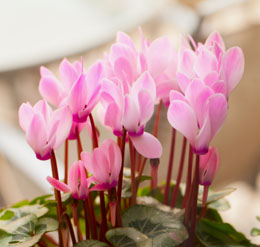Chic and delicate, Cyclamens are flowers that will fascinate with their beauty provided that you know their little secrets. Take a look to see what they need.

These gorgeous and sophisticated flowers, although are often kept as houseplants, can be found in wilderness, too. I've personally had the pleasure and surprise of discovering them on Mount Carmel, Israel (sometime in the beginning of March).
Cyclamens are perennial plants with twisted, whitish-green leaves. They are easily noticeable due to the beauty of their white, red, purple, and pink flowers. Each flower is placed on a stem which comes from the tuber's growing point. No matter what the species is, the stem is about 180° bent at the tip. The nose of the flower faces downwards. Flowers have five petals which are bent up or outwards, which are sometimes twisted, and connected at the base of the flower into a cup. There are also five sepals behind the cup.
The Cyclamen genus has about 20 perennial species originating in different habitats. Wild species should be cultivated in opens spaces, in shady areas, and the more delicate species are to be planted indoors or in greenhouses. After selections and hybridization, horticulture specialists have created a multitude of cultivations, with enchanting flowers and a refined perfume.
This plant prefers luminous rooms, with moderate temperature (i.e. not higher than 20˚C), with high humidity atmosphere. This can be attained by spraying water on the leaves. The substrate watering should be moderate, minding that excessive water should be eliminated. Cyclamens can't stand to be exposed to drafts of air. They usually blossom between the months of September-March. After the flowers are dried out, watering is gradually reduced, and leaves get dry and fall down. Cyclamens then go into a dormant state (between the months of April-July).
During its dormant state, the plant needs to be kept in a cool dark place in its respective pot or can be taken out of its soil and kept in sand or in a plastic bag with airing holes. In order for the plant to blossom again, we must stop watering it until the appearance of the new leaves. When new leaves pop up, Cyclamens should be watered more often. The substrate must be a mixture made of 4 parts of leaves' soil and one part of sand.
Cyclamens can be propagated by the division of the tubers (around the end of spring) or by seeding (between the months of July and September). The plant's fruit bears a capsule containing about 30 seeds. Cyclamen species are poisonous, and were used as purgatives in ancient times.
If cultivated in proper conditions, Cyclamen can live up to three or four years. In order to enjoy its beauty as much as possible, it is essential to observe the development requirements. Thus, cyclamen prefers well-lit spaces, with plenty of fresh air and high level of humidity. One must not expose it directly to the sun or to air drafts. As far as the temperature requirements are concerned, the optimum values for them to develop naturally and normally are around 18-21˚C at daytime and 10˚C at nighttime. We should also be careful about excessive heating, because heaters can determine the fading of flowers and finally, the drying of the plant.
In autumn and winter time, we should try to keep a permanently humid soil. For this purpose, the best thing to do is to pour water onto the pot holder, to let it there for about 20 minutes, and then remove the water which has not been absorbed by the compost. Thus, we can prevent the storing of water and rotting of the plant. The same risk of rotting can also be present when we spray the leaves and the flowers.
At the same time, we must remember to permanently clean the plant of its dried leaves and flowers. During the blossoming season, we should fertilize it every two weeks with a liquid fertilizer, diluted into the water; this way, flowers and leaves shall develop completely. After the end of the blossoming season, cyclamen enters its dormant stage. During this stage, as mentioned earlier, we should avoid watering or fertilizing the plant.
In order to replant the cyclamen, one should use an equal mixture of garden soil, forest soil, peat and sand. We should also be careful to add a few pieces of terracotta on the pot's bottom, in order to ensure proper drainage.






 These gorgeous and sophisticated flowers, although are often kept as houseplants, can be found in wilderness, too. I've personally had the pleasure and surprise of discovering them on Mount Carmel, Israel (sometime in the beginning of March).
These gorgeous and sophisticated flowers, although are often kept as houseplants, can be found in wilderness, too. I've personally had the pleasure and surprise of discovering them on Mount Carmel, Israel (sometime in the beginning of March).